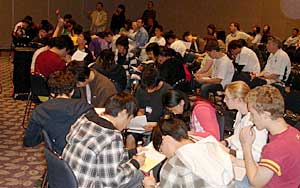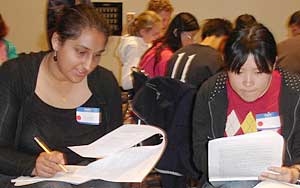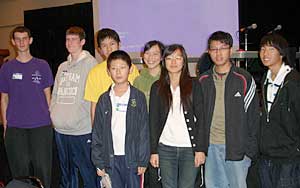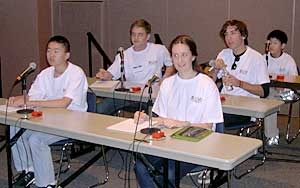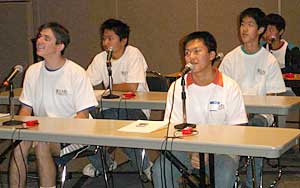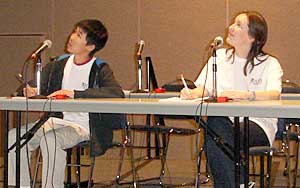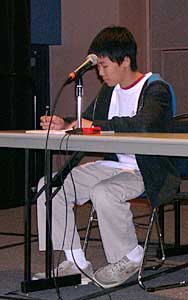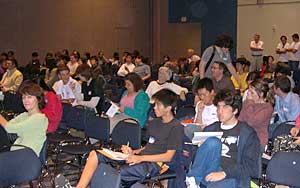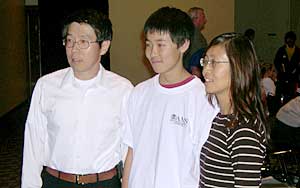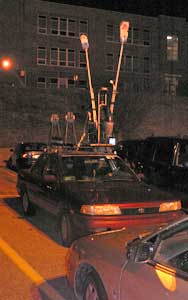
Who Wants to Be a Mathematician at California State University, Fullerton
|
|
|
"Thanks again for all you do in arranging this contest. Our students were very excited to be going."
"It was a wonderful event and everybody enjoyed it."
George Xing of University High School in Irvine capped off a day of mathematics--hosted by the Math Zoom Academy--which featured two exciting competitions and a lecture, by winning US$3000 in Who Wants to Be a Mathematician on Saturday, December 6 at California State University, Fullerton. The day began with a lecture on graph theory by Paul Dreyer of the Rand Corporation, continued with over 30 Los Angeles-area high school students competing in the first Southern California Mathematical Olympiad, run by the Math Zoom Academy, and finished with 10 Los Angeles-area high school students playing two games of Who Wants to Be a Mathematician.
Six Degrees of Graph Theory: Kevin Bacon, Paul Erdős, William McKinley, and Me, Paul Dreyer (the Rand Corporation)
Dreyer spoke about paths between nodes in some well-known graphs, or networks. He began with a graph of actors who are represented as vertices (nodes) and joined by an edge if they have appeared in a movie together. Actors A, B, and C are connected by a path of length two if A has appeared in a movie with B and B has appeared in a movie with C. If A and C have not appeared in a movie together, then the distance between them is two. Longer paths, and longer distances, are found similarly.
|
|
Kevin Bacon is famous for being connected to many actors. Actors who have appeared in a movie with him are said to have a Bacon number of one. Larger Bacon numbers are equal to the length of the shortest path to Bacon. If no path exists to an actor, then that actor is said to have an infinite Bacon number. The average distance from Bacon to actors with a finite Bacon number is less than three. Yet that is not the smallest average distance for actors: Rod Steiger and Christopher Lee have lower average distances, 2.679 and 2.684, respectively. These low numbers are surprising, but Dreyer pointed out that results in graph theory almost guarantee that such distances will be small. Former U.S. president William McKinley (president from 1897-1901) is in the graph as well because he appeared in a movie that also included a 19th century general who has a Bacon number of eight.
Mathematicians have a similar graph, governed by co-authorship rather than movies. Of particular interest is the late prolific mathematician Paul Erdős. People have an Erdős number of one if they co-authored a paper with Erdős. If mathematician A has co-authored a paper with someone who has an Erdős number of one, and A did not co-author a paper with Erdős, then mathematician A has Erdős number two, and so on. Dreyer himself has an Erdős number of two. The actress Danica MacKellar is one of a few people who have a finite Erdős number and a finite Bacon number.
Near the end of his talk, Dreyer told a funny story of a close encounter with Erdős. Dreyer was giving a talk at a conference in Germany, concurrent with one other talk going on in another room. He saw Erdős come into the room and speak to the organizer. “Who is the speaker?” Erdős asked.
“Paul Dreyer,” said the organizer.
“Where is he from?”
“New Jersey.” Dreyer was at Rutgers University at the time.
“What’s the title of the talk?”
“Knot Theory and the Human Pretzel Game.”
“Abstract?” The organizer handed Erdős the abstract. Erdős read it and asked, “Who is in the other room?”
Dreyer joked that it took years of therapy to get over the incident.
Southern California Mathematical Olympiad (SCMO)
|
|
|
In this competition, students were grouped into four teams of eight to answer 40 challenging mathematics questions. Each team member had printouts of the questions. Team members answered orally and each team had two opportunities to answer a question. If an answer was correct, then that team got one point for the question and other teams could no longer answer that question. The team with the most points at the end of an hour, or when all questions had been answered, was the winner.
At the end of the hour, when only a few of the difficult questions remained unanswered, two teams had tied with 12 correct answers. So one member from each tied team came to the front to answer the tie-breaking question (How many zeros are at the end of 1000 factorial?). The Green team's David Yang (pictured below in the blue jacket, in front) was the first to answer correctly, winning the SCMO for the very happy Green team (pictured below).
|
|
Who Wants to Be a Mathematician
These games weren’t as intense as the finish of the SCMO, but they were equally exciting. In a Who Wants to Be a Mathematician first, all ten contestants, pictured below, scored a perfect 10 on the qualifying test.
|
|
(left to right)
- Kevin Yin, San Marino High School
- David Ke, Arcadia High School
- Hansen Han, Christian High School
- Stephen Yoo, Fairmont Preparatory School
- Oleksandr Stubailo, South Pasadena High School
- Mike Breen, American Mathematical Society Public Awareness Officer (and game emcee)
- Matthew Alexander, Loyola High School
- Raku Watari, Corona Del Mar High School
- George Xing, University High School
- Ricky Demer, Village Glen West High School
- Rebecca Jacobs, Harvard-Westlake School
|
|
Game one, like the SCMO, also wound up in a tie, between Kevin Yin, a sophomore, and Rebecca Jacobs, a senior, who each missed only one question. In the tie-breaker between the two contestants, in which the first person who answered the one question correctly would win the game, both contestants were wrong on their first attempt, but Rebecca was right on her second attempt, and earned a spot in the Square-Off Round. (Front: Kevin Yin, Rebecca Jacobs; Second Row: Oleksandr Stubailo, Matthew Alexander; Back: Stephen Yoo.) |
|
|
Game two was also close, but in this case there was a three-way tie for third between Hansen Han, David Ke, and Raku Watari, which was resolved later. First place belonged to George Xing, a junior, who also missed only one question. (Front: Ricky Demer, Hansen Han; Second Row: David Ke, Raku Watari; Back: George Xing.) |
|
|
So Jessica and George “squared off” on one question. As in the tie-breaker, the first person to answer correctly would win the round and advance to the Bonus Round: one question worth $2000. It was George who answered first—very quickly and correctly. |
|
|
George didn’t answer as quickly in the Bonus Round, he had three minutes to work with, but those in attendance could tell from his explanation (after time had expired) that he knew what he was talking about and that he was very confident in his answer. The audience members got a chance to pick their favorite, before George’s explanation, and chose the same answer as George.
|
|
Before the answer was revealed, George said that he was going to use whatever cash he won for a school band trip to Hawaii. He and the audience were correct, which brought George’s winnings for the day to $3000. Aloha, George (pictured below, at right, with his parents).
|
|
|
Here are the prizes won by the ten contestants:
- TI-Nspire graphing calculator from Texas Instruments, and $3000 from the AMS: George Xing
- TI-Nspire graphing calculator from Texas Instruments and $500 from the AMS: Rebecca Jacobs
- Maple 12 from Maplesoft: Kevin Yin and Ricky Demer
- What's Happening in the Mathematical Sciences from the AMS: Oleksandr Stubailu and Hansen Han
- Calculus with Early Transcendentals by Anton, Bivens and Davis from John Wiley and Sons: Matthew Alexander and Raku Watari
- Five-Minute Mathematics from the AMS: Stephen Yoo and David Ke
Thanks to Kevin Wang and Kelly Ren of the Math Zoom Academy for all their work making local arrangements and organizing the SCMO. Thanks also to the sponsors Texas Instruments, Maplesoft, and John Wiley and Sons, for their continued support of Who Wants to Be a Mathematician.
More photos of the day's events are available here. Two non-traditional photos from the trip are below.
|
Is there an ex-presidential suite? |
|
Photographs by Who Wants to Be a Mathematician judge and co-creator Bill Butterworth (DePaul University Department of Mathematical Sciences), Kelly Ren (Math Zoom Academy), and Mike Breen.
Find out more about Who Wants to Be a Mathematician.





